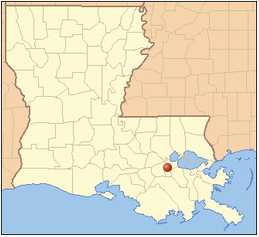| Home | Search | Emissions | Pollutants | About the Database |

Marathon Ashland Petroleum (3165), Garyville
LDEQ Accident Report
| Accident # | 148554 |
| State Police # | 13-01954 |
| Accident Date | 2013-05-06 |
| Report Date | 2013-05-10 |
| Follow-up Date | 0000-00-00 |
| Follow-up: | No |
Pollutants Released
| Pollutant | Duration | Point Source | Greenhouse Gas | Criteria Pollutant | Ozone forming chemical | Amount of Release |
| Asphalt | Tank Farm, Tank 300-5 pump, FUG-0084 (Unit 63 Fugitives) | NO | NO | NO | 2,982.0 gallons |
Accident Classified As: Below Reportable Quantity (BRQ)
Cause of Problem: Piping or Tubing
Incident at the refinery's tank farm which resulted in a spill of asphalt. On May 6, the asphalt pump 63-1539-02 was started to put Tank 300-5 on tank circulation. An hour and a half later, the operator noticed asphalt spraying from a cracked 3/4" relief valve inlet line. The definition of oil provided in LAC 33:1.3905 states that an oil is "any of numerous smooth, greasy, combustible hydrocarbons that are liquid or at least liquefiable on warming, are soluble in ether but not in water, including but not limited to crude oil, petroleum, fuel oil, sludge, oil refuge, and oil mixed with wastes other than dredge spoil." Asphalt is not a combustible liquid and requires high temperatures to become a liquid; therefore, asphalt does not meet this definition of an oil. Therefore no reportable quantities were exceeded during this event.
Discharge Preventable - Under Investigation
Notes/Remedial Actions
Immediate remedial action was to shut down the asphalt pump as soon as the spill was discovered. Once investigation is complete, recommendations to prevent recurrence will be implemented. No reportable quantities were exceeded because asphalt does not meet any of the conditions to be defined as an oil. The definition of oil provided in LAC 33:I:3905 states that an oil is "any of numerous smooth, greasy, combustible hydrocarbons that are liquid or at least liquefiable on warming, are soluble in ether but not in water, including but not limited to crude oil, petroleum, fuel oil, sludge, oil refuse, and oil mixed with wastes other than dredge soil." Asphalt is not a combustible liquid and requires high temperatures to become a liquid.

Connect With Us: